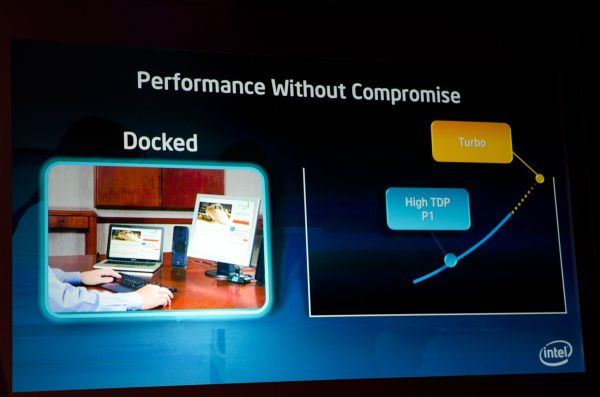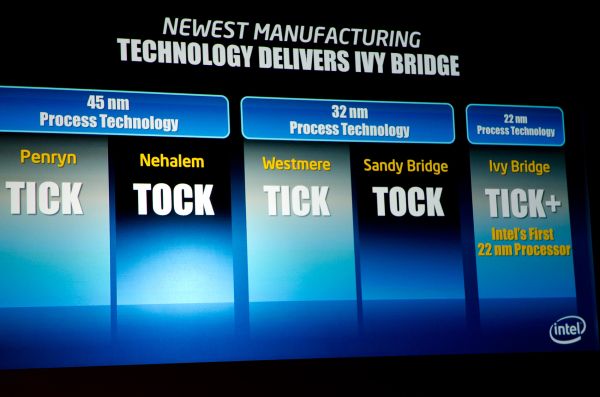Ivy Bridge: A Tick+ With Configurable TDP
by Anand Lal Shimpi on May 31, 2011 4:26 AM EST- Posted in
- Trade Shows
- CPUs
- Intel
- Ivy Bridge
- Computex 2011
With Turbo boost and power gating we took a step towards configurable CPUs. It didn't matter whether you needed one core or four, with power gating and turbo you got the best combination of active cores and clock speed. It has enabled platforms like quad-core notebooks that don't sacrifice performance in lightly threaded applications.
With Haswell Intel already committed to dropping notebook TDPs from 35 - 45W down to the 10 - 20W range. As a result you get thinner notebooks, but you do sacrifice peak performance. Intel doesn't want to make that tradeoff, so Ivy Bridge will be the first Intel CPU to introduce configurable TDP.
Ivy Bridge turbo won't just run up to the hard limits of your TDP, but it'll be able to exceed that TDP significantly (Intel wouldn't comment on the exact numbers) until the CPU gets too hot. You can imagine a 15W TDP part that could turbo up to 35W TDP for a matter of seconds to make your system feel ultra snappy without requiring a thicker notebook.
The ultra configurable TDP will also have support for a docked mode. So if you take your Ivy Bridge notebook, stick it on a docking station with better cooling you'll be able to exceed the system's TDP consistently. Now your 15W TDP part works like a 35W TDP part because you've given it more cooling.
Configurable TDP will start with Ivy Bridge, but it'll be absolutely necessary (and likely much better) with Haswell. Look at what Turbo did from Nehalem to Lynnfield and I'm guessing we'll see the same sort of transition with Ivy Bridge to Haswell.
Ivy Bridge's configurable TDP will help OEMs build ultra thin notebooks without sacrificing performance - particularly when docked.
By the way, Intel views Ivy Bridge as more than just a process shrink as a result of all of this (and more apparently). It's still not a tock, but a Tick+.


















17 Comments
View All Comments
ahmedz_1991 - Tuesday, May 31, 2011 - link
if this really works out, it'll be a huge gain for the netbook industry! i guess we'll wait and c !ketchup79 - Tuesday, May 31, 2011 - link
This new "breakthrough," at least the way it is presented in this article, is little more than marketing hype of something that is already there. I am not exactly badmouthing Intel for doing so, but somewhat disappointed nonetheless.Kiji - Tuesday, May 31, 2011 - link
"Ivy Bridge's configurable TDP will help OEMs build ultra thin notebooks without sacrificing performance - particularly when docked." - Can someone explain me what do you mean by docked ?hyvonen - Tuesday, May 31, 2011 - link
Remember docking stations? You know, those small hubs where you can connect your external displays, full-size keyboard and mouse, ethernet cable etc? Just "dock" your laptop and you have a desktop-like environment to work with.In this context, I think the difference between "docked" and "undocked" might be that the docking station somehow cools the laptop/CPU from the bottom of the laptop case, allowing higher performance because the system can now handle the increased heat generation... this probably works both temporarily (higher turbo) and sustainably (higher clock for long-term loads).
At least that what it sounds like to me.
GullLars - Tuesday, May 31, 2011 - link
You really don't need a docking station for that though, i've had a chillpad for my laptop for 2 years, since it overheated the GPU when i played Age of Conan and COD MW2. I can even run GPU and CPU folding@home at the same time when it's on the chillpad and keep CPU under 50C and GPU under 70C. (GPU shuts down from overheating around 85C)uncle29 - Tuesday, May 31, 2011 - link
Adjustable TDP is old news. ThrottleStop has allowed users to adjust this on the 920XM/940XM Extreme mobile CPUs as well as the original Core i5 and Core i7 32 nm CPUs for the last year.ThrottleStop 3.00
http://www.techinferno.com/downloads/?did=1
The world's fastest Extreme users are all running ThrottleStop and even the low power UM processors have seen performance increases of over 50% while using this little utility to adjust TDP/TDC.
ssj4Gogeta - Wednesday, June 1, 2011 - link
Current mobile processors underclock and undervolt according to the power scheme you set in your OS. So if your processor's TDP is 30W and you've set your processor to throttle down when not in use or when unplugged, it consumes let's say 15W when throttled down.So Intel now brands the processor as having 15W TDP, but consuming 30W when plugged, instead of calling it 30W TDP and consuming 15W when unplugged. The only difference seems to be that the change depends on temperature.